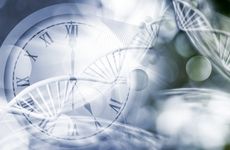
NEW YORK — Researchers have found that the biological age of humans and mice rapidly increases in response to stress. However, that biological age can decline following recovery from the stressful situation.
Previous studies have shown that biological age can increase with stress and even fluctuate, but the authors said their study suggests biological age could be reversed.
"This finding of fluid, fluctuating, malleable age challenges the longstanding conception of a unidirectional upward trajectory of biological age over the life course," co-senior author James White, an assistant professor of medicine at Duke University School of Medicine, said in a press statement.
For this study published in Cell Metabolism on Friday, researchers conducted several experiments in mice and humans, using multiple independent epigenetic aging clocks.
In mice, the researchers surgically attached pairs of mice that were 3 months old and 20 months old in a procedure known as heterochronic parabiosis, which connected their circulatory systems. They then used multiple approaches to gauge methylation levels in liver, heart, brain, kidney, and adipose tissue samples from the mice, finding an increase in biological aging among young mice. Following surgical detachment and recovery, the biological age of the mice returned to baseline.
Transcriptomic and metabolic analyses further supported the finding that the biological age of the young mice indeed increased before then declining after detachment.
"An increase in biological age upon exposure to aged blood is consistent with previous reports of detrimental age-related changes upon heterochronic blood-exchange procedures," first author Jesse Poganik, a researcher at Brigham and Women's Hospital and Harvard Medical School, said in a statement. "However, reversibility of such changes, as we observed, has not yet been reported. From this initial insight, we hypothesized that other naturally occurring situations might also trigger reversible changes in biological age."
To test their hypothesis, researchers moved to human samples. They examined DNA methylation of blood samples from elderly patients who had undergone major surgery and found a significant increase in biological age markers using multiple epigenetic clocks.
"Remarkably, this increase occurred in under 24 hours, and biological age returned to baseline 4 [to] 7 days post-surgery," the authors wrote. They however didn't see the same effects following two other non-trauma surgeries.
Meanwhile, they also saw reversible changes in biological age in response to pregnancy and COVID-19, implying that such changes may be rather common responses to stress.
The authors noted, though, that their findings are limited in their ability to probe the connections between short-term fluctuations in biological age and lifelong biological aging trajectories. "A key area for further investigation is understanding how transient elevations in biological age or successful recovery from such increases may contribute to accelerated aging over the life course," White added.
